TAIPEI, Taiwan, February 16, 2015 – Once upon a time,
not so far ago, USB became the most common standard for connecting
peripherals to our computers. It has also received several upgrades over
the years, including this year's jump to USB 3.1. Needless to say, PC
builders are going to find these new interfaces on their forthcoming
motherboards from all brands, but ASRock's X99 and Z97 motherboards have
more up their sleeves. Besides the traditional Type-A connectors,
they're going to be the first in the world to carry the Type-C 10 Gb/s
SuperSpeed+ USB 3.1, which supports next generation mobile devices.
 The
main attraction of the next generation SuperSpeed+ USB 3.1 is that it
has doubled the data signaling rate of the former 5 Gb/s USB 3.0 to 10
Gb/s for new USB 3.1 supporting devices. In other words, transferring
files from storage devices is about to become two times faster, while
these most common Type-A connectors are still backwards compatible with
the current USB 2.0 and 3.0 devices.
The
main attraction of the next generation SuperSpeed+ USB 3.1 is that it
has doubled the data signaling rate of the former 5 Gb/s USB 3.0 to 10
Gb/s for new USB 3.1 supporting devices. In other words, transferring
files from storage devices is about to become two times faster, while
these most common Type-A connectors are still backwards compatible with
the current USB 2.0 and 3.0 devices.

 One
of the world's first motherboard to be equipped with Type-C USB 3.1
will be ASRock's Z97 Extreme6/3.1. Much like its previous version, this
motherboard will bear ASRock's Super Alloy features, a PCIe Gen3 x4
Ultra M.2, a Thunderbolt AIC connector, quad CrossFireX, quad SLI, and
Purity Sound2. Furthermore, apart from the 10 USB 3.0 and 5 USB 2.0
connectors onboard, this motherboard also sports an USB 3.1 add-on card
with both a single USB 3.1 Type-A port and a Type-C port. Another new
piece of Super Alloy Series motherboard that's getting a dose of USB 3.1
is ASRock's X99 Extreme6/3.1. It will also come with Ultra M.2, a
Thunderbolt AIC connector, 3-Way CrossFireX or SLI, and Purity Sound2.
Plus an USB 3.1 add-on card that supports two USB 3.1 Type-A ports, an
onboard USB 3.1 Type-C port for next generation devices, and a
bucketload of traditional USB ports as well.
One
of the world's first motherboard to be equipped with Type-C USB 3.1
will be ASRock's Z97 Extreme6/3.1. Much like its previous version, this
motherboard will bear ASRock's Super Alloy features, a PCIe Gen3 x4
Ultra M.2, a Thunderbolt AIC connector, quad CrossFireX, quad SLI, and
Purity Sound2. Furthermore, apart from the 10 USB 3.0 and 5 USB 2.0
connectors onboard, this motherboard also sports an USB 3.1 add-on card
with both a single USB 3.1 Type-A port and a Type-C port. Another new
piece of Super Alloy Series motherboard that's getting a dose of USB 3.1
is ASRock's X99 Extreme6/3.1. It will also come with Ultra M.2, a
Thunderbolt AIC connector, 3-Way CrossFireX or SLI, and Purity Sound2.
Plus an USB 3.1 add-on card that supports two USB 3.1 Type-A ports, an
onboard USB 3.1 Type-C port for next generation devices, and a
bucketload of traditional USB ports as well.


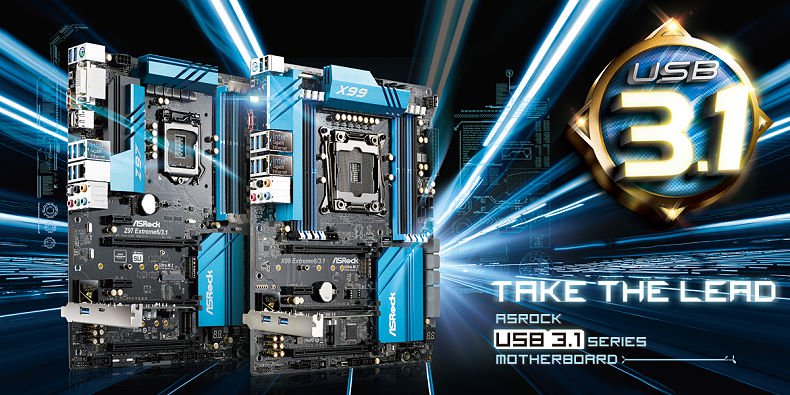 The
main attraction of the next generation SuperSpeed+ USB 3.1 is that it
has doubled the data signaling rate of the former 5 Gb/s USB 3.0 to 10
Gb/s for new USB 3.1 supporting devices. In other words, transferring
files from storage devices is about to become two times faster, while
these most common Type-A connectors are still backwards compatible with
the current USB 2.0 and 3.0 devices.
The
main attraction of the next generation SuperSpeed+ USB 3.1 is that it
has doubled the data signaling rate of the former 5 Gb/s USB 3.0 to 10
Gb/s for new USB 3.1 supporting devices. In other words, transferring
files from storage devices is about to become two times faster, while
these most common Type-A connectors are still backwards compatible with
the current USB 2.0 and 3.0 devices.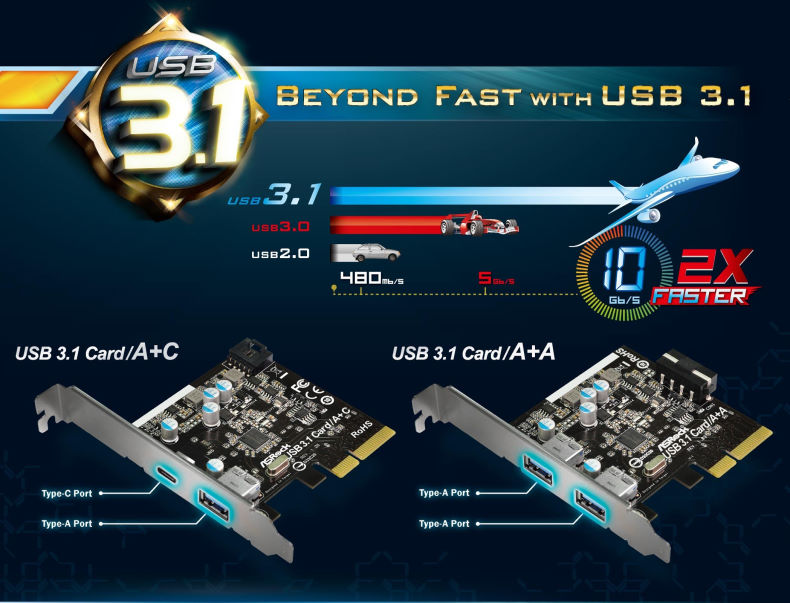
USB 3.1 boosts the current data rate from 5 Gb/s to 10 Gb/s!
Something
else worth mentioning is the birth of the new Type-C USB 3.1 interface,
which purposedly would serve as an integration of all our future input
output interfaces. This breaks the compatibility with the existing
Type-A connectors, but on the bright side, after years of keeping
fingers crossed, frantically fumbling Type-A USB connectors behind
computer cases in hope of getting the correct orientation, the long
overdue reversible Type-C USB interface has finally arrived, adding one
more entry to the things certain in life. Moreover, during this
transition period, ASRock is planning to support both Type-A and Type-C
USB 3.1 connectors. Other merits of this new Type-C interface include
smaller size, which is inevitable since the sizes of our devices are
shrinking as well. Strengthened durability to support over ten thousand
plugs and removals, and a huge leap from the former 0.9 ampere power
current on USB 3.0 to USB 3.1's 3 ampere power currents for extra fast
device charging.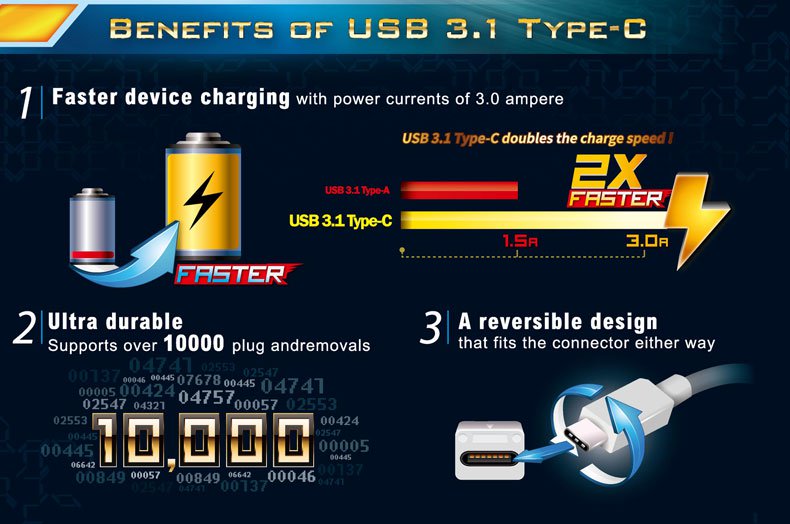 One
of the world's first motherboard to be equipped with Type-C USB 3.1
will be ASRock's Z97 Extreme6/3.1. Much like its previous version, this
motherboard will bear ASRock's Super Alloy features, a PCIe Gen3 x4
Ultra M.2, a Thunderbolt AIC connector, quad CrossFireX, quad SLI, and
Purity Sound2. Furthermore, apart from the 10 USB 3.0 and 5 USB 2.0
connectors onboard, this motherboard also sports an USB 3.1 add-on card
with both a single USB 3.1 Type-A port and a Type-C port. Another new
piece of Super Alloy Series motherboard that's getting a dose of USB 3.1
is ASRock's X99 Extreme6/3.1. It will also come with Ultra M.2, a
Thunderbolt AIC connector, 3-Way CrossFireX or SLI, and Purity Sound2.
Plus an USB 3.1 add-on card that supports two USB 3.1 Type-A ports, an
onboard USB 3.1 Type-C port for next generation devices, and a
bucketload of traditional USB ports as well.
One
of the world's first motherboard to be equipped with Type-C USB 3.1
will be ASRock's Z97 Extreme6/3.1. Much like its previous version, this
motherboard will bear ASRock's Super Alloy features, a PCIe Gen3 x4
Ultra M.2, a Thunderbolt AIC connector, quad CrossFireX, quad SLI, and
Purity Sound2. Furthermore, apart from the 10 USB 3.0 and 5 USB 2.0
connectors onboard, this motherboard also sports an USB 3.1 add-on card
with both a single USB 3.1 Type-A port and a Type-C port. Another new
piece of Super Alloy Series motherboard that's getting a dose of USB 3.1
is ASRock's X99 Extreme6/3.1. It will also come with Ultra M.2, a
Thunderbolt AIC connector, 3-Way CrossFireX or SLI, and Purity Sound2.
Plus an USB 3.1 add-on card that supports two USB 3.1 Type-A ports, an
onboard USB 3.1 Type-C port for next generation devices, and a
bucketload of traditional USB ports as well.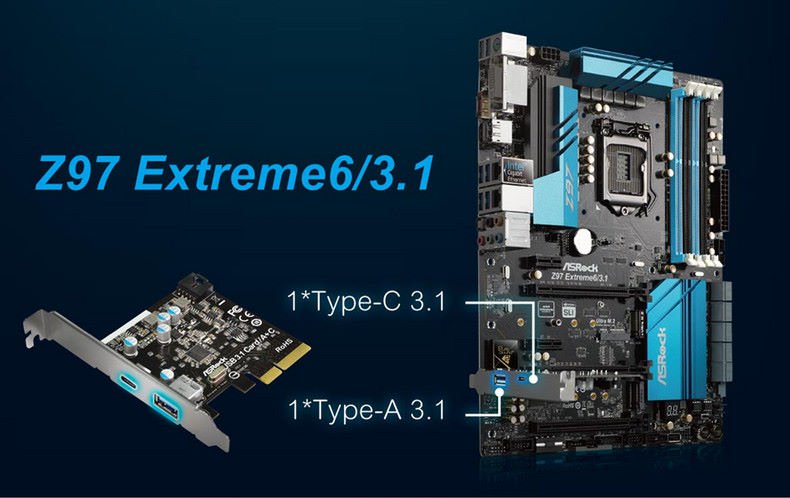
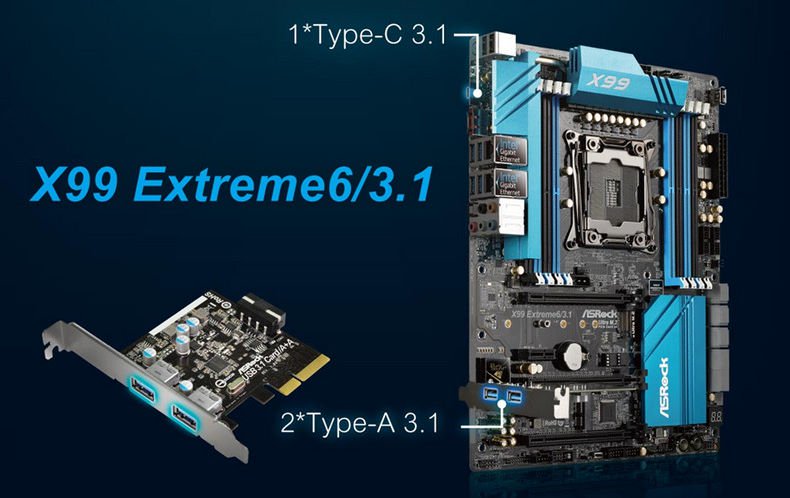

No comments:
Post a Comment